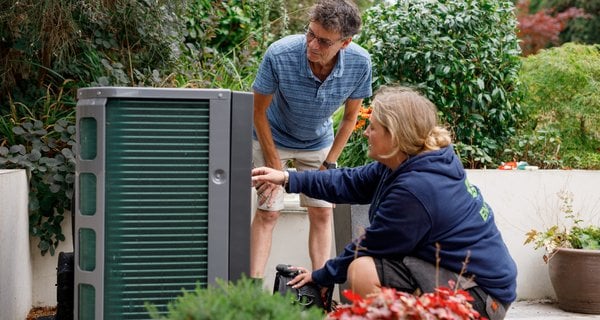What are the challenges with running apprenticeships and using them to rapidly grow the sector?
Our research insights are focused on the two apprenticeships most relevant to the heat pump sector: the plumbing and domestic heating apprenticeship (including the final year environmental pathway option) and the low carbon heating technician apprenticeship.
The challenges we identified through our research can be broken down into three themes:
- Challenges employers face when taking on, and employing, an apprentice
- Challenges colleges face with implementing the plumbing and domestic heating apprenticeship environmental pathway and the low carbon heating technician apprenticeship
- Challenges with using apprenticeships to rapidly grow the heat pump engineer workforce
These themes are explored below, but they can also be viewed on the apprenticeship pathway diagram to better understand where and when challenges may occur.
Challenges employers face when taking on an apprentice
Financial investment
The financial investment of taking on an apprentice is a major challenge many business owners face, explained by the prevalence of micro-businesses in the sector. Although the government covers 95%-100% of college fees, employers have to pay the apprentice’s wage. This can be particularly difficult for employers when apprentices add limited extra value to the business in the first year or two, and as the employer is paying for their time in college too. First-time apprentice employers, those in the smallest businesses, those expanding from sole trading and those taking on an older apprentice find this notably difficult.
There are also other extra costs employers must cover, in addition to apprentice wages, such as different types of insurance, new or replacement tools and uniforms.
Although it didn’t emerge as one of the most important challenges, many business owners have experienced apprentices or applicants that have a bad attitude, poor motivation and low desire to learn. Many have said that this is more likely to be the case with the youngest apprentices (16 and 17-year-olds) and that older apprentices (over the age of 21) are generally very motivated, have a strong desire to learn and have a generally better attitude. Despite this leading to a preference for older apprentices for some, they can be prohibitively expensive to hire due to the higher minimum wage for those over 18 or over 21. This can prevent employers from being able to take on the best apprentice for their business or discourage them from taking on an apprentice at all.
Finding appropriate training courses
A large challenge for heat pump business owners is finding a college offering relevant training for their potential apprentice. At the end of 2024, there were just 3 colleges offering the low carbon heating technician apprenticeship across Great Britain and interviewees reported difficulty in finding colleges that offer the environmental pathway for the plumbing and domestic heating apprenticeship. Adding to this challenge, a suitable college must be located close enough to the apprentice or employer, and with good public transport links, as many apprentices can’t drive when they first start the course.
Although some employers who work with both gas boilers and heat pumps may be able to send their apprentices on the gas pathway of the plumbing and domestic heating apprenticeship instead of a more appropriate course, many face challenges with this too.
Firstly, many employers who work predominantly with heat pumps may not do enough gas-related work to allow the apprentice to gain the relevant experience or portfolio evidence required by the course. Businesses may also have to alter their business plans and take on gas-related jobs they wouldn’t otherwise do, to best support their apprentice. Similarly, the plumbing and domestic heating apprenticeship has a wide curriculum, making it hard for some employers to offer all of the relevant experience to their apprentice.
Even if businesses are open to taking on different jobs to support their apprentice through the gas pathway, colleges may decline to work with companies if they don’t believe they can provide the student with ample experience.
This means it’s not only difficult to find an appropriate course provider, but that those willing to use workaround solutions may be presented with a fresh set of challenges.
Post-apprenticeship retention
Many business owners are wary that a newly qualified apprentice could leave the business after the employer has spent three to four years of time and money investing in their training. Not only would this be a loss on investment for business owners, but there’s a risk apprentices could work in direct competition with them. There’s often little to prevent this, leading some to be discouraged from taking on an apprentice.
College communications
Some employers experience issues with communications from colleges, though this varies dramatically depending on the college with many employers reporting very positive experiences too.
In addition to a general update on apprentice performance, employers especially value being kept up-to-date on information about the experiences their apprentice needs to fulfil for their portfolio when the college tutor wants to conduct a site visit and what they’d like to assess. Some employers also like to have information on the curriculum, so they can try to align the jobs they’re giving apprentices with what's being taught in colleges.
Communication about this allows them to best support their apprentice, whilst also running their business in an efficient way. For example, it allows them to plan and schedule jobs around certain tasks if they’re needed for an assessor visit or for the apprentice’s portfolio. Poor communication on this can lead to employers having to find similar jobs to replicate experiences that were already covered but not recorded or assessed.
Whilst poor communication from colleges can certainly add challenges to running a business and taking on an apprentice, our interviews suggest that it isn’t a major barrier to taking on apprentices.
Challenges colleges face with implementing the plumbing and domestic heating apprenticeship environmental pathway and the low carbon heating technician apprenticeship
Course demand
Our research suggests that many colleges don’t offer the low carbon heating technician apprenticeship or the environmental pathway of the plumbing and domestic heating apprenticeship as they can’t see enough demand from local businesses.
Colleges generally need roughly 15 students in each cohort to make it worth running a course; though this could be closer to 8 students when running a new course. It’s understandable that securing enough students, all starting at the same time, to run these courses could be difficult within the limits of a college’s catchment and given the small size of the heat pump sector.
However, there’s also a chance that some of the demand for these courses is being diluted. Some businesses have stopped requesting the course from colleges, either because they’ve given up on trying to persuade them, or they’ve developed their own workaround.
For example, some employers mentioned that they used to withdraw their apprentice from the course after they achieved a level 2 certification and sent them on a series of training courses to gain the relevant qualifications for installing heat pumps (though this is no longer possible). Similarly, many companies that also work with gas are simply sending their apprentices on the gas pathway of the plumbing and domestic heating apprenticeship in lieu of a better option.
Similarly, some business owners who want their apprentice to be qualified in both gas and heat pumps may actually be content with sending their apprentice on gas-related apprenticeships, as it’s a more efficient use of the government funding, covers a wider range of skills, feels familiar to the employer, and results in a more tangible and widely-recognised qualification for the apprentice. Therefore, they may not be proactively requesting the college to run the environmental pathway or low carbon heating technician apprenticeship courses, even if they would use it if it was available.
Course tutors
Our interviews with colleges suggest that the lack of trainers competent in low-carbon heating technologies is a major barrier to them offering the low-carbon heating technician apprenticeship or the environmental pathway of the plumbing and domestic heating apprenticeship. This is because the heat pump sector is relatively small, and many of those with the knowledge to teach these courses are working in heat pump installation, servicing or repairs. There’s also a wider shortage of plumbing tutors, and high turnover in this field, which limits the number of tutors that can be trained and upskilled in teaching these courses.
Although plumbing and gas tutors can attend heat pump courses to prepare themselves for teaching the apprenticeships, this may not be enough to make them feel confident enough to teach such courses, especially after feeling very confident teaching plumbing and gas. Additionally, some may feel as if the apprentices they’re teaching will very quickly have more practical experience with heat pumps than they do, increasing this lack of confidence.
Some tutors have shadowed heat pump engineers to try and gain extra knowledge and confidence, but colleges have mentioned it’s hard to fit this in around the rest of their responsibilities.
Competing courses
The fact that there are multiple similar apprenticeships relating to heating and plumbing amplifies the issues of low course demand and the availability of tutors discussed above. Although each course is distinct, there are similarities in the type of employer who would want to send their apprentice on the plumbing and domestic heating apprenticeship, the low carbon heating technician apprenticeship, and other related qualifications, such as the gas engineering operative apprenticeship. There is also some crossover with who can teach these courses. This can make it difficult for colleges to offer multiple courses, as it’s harder to meet the minimum cohort size and find enough college tutors to do so.
Investment in new courses and space
Colleges need to invest in new equipment, allocate training space, and develop a new curriculum and course materials in order to run the low-carbon heating technician apprenticeship or the environmental pathway of the plumbing and domestic heating apprenticeship. They also need to have guaranteed continual demand to make this investment in equipment, time and using the physical space worthwhile. However, colleges can’t see the demand for these courses, and they don’t receive any extra money for these apprenticeships than they do for the Gas Pathway apprenticeship. This lowers their expected return on the initial investment and reduces their incentive to put resources into offering such apprenticeships.
Challenges with using apprenticeships to rapidly grow the heat pump engineer workforce
A preference for younger apprentices
Some employers would prefer to take on older apprentices but are prevented from being able to do so by the higher minimum wage. There are perceived benefits to taking on older apprentices, over the age of 21. For example, older apprentices are often considered more reliable, motivated and have a more mature attitude. They can also learn more quickly and add value to the business sooner. These traits are often challenges employers face when looking for potential apprentices who have just finished school.
Because of this, some employers would prefer to take on older apprentices but are prevented from being able to do so by the higher minimum wage.
The inability to take on older apprentices diminishes the ability to use apprenticeships to rapidly grow the heat pump sector’s workforce or output. This situation is excluding a cohort of potential apprentices from contributing to the growth of the industry and preventing some employers that prefer older apprentices from taking one on at all. It could also prevent a pool of potential heat pump apprentices from entering the sector who might be able to add more value or productivity to the industry more quickly than their younger counterparts.
Initial assessment
The initial assessment is an opportunity for the college, employer and apprentice to discuss each of their needs and modify the apprenticeship to match these if needed. As part of this, it can be used to shorten or restructure an apprenticeship for those with previous experience, skills and qualifications. This could make it a useful way to rapidly grow the workforce by shortening the course for individuals in adjacent industries who might have transferable skills.
However, doing this in practice may be difficult. This is because a framework is usually used to match a student’s previous qualifications to the relevant apprenticeship course modules. This is then used to determine which portions of the course can be omitted and if the student could undertake a shorter course. This means that colleges are unlikely to shorten a course for someone who lacks qualifications, but might otherwise have transferable skills or practical experience. An employer can still try and persuade the college to shorten an apprenticeship for a potential student without qualifications, but this requires a lot of time and motivation from the employer, which may not be available for the many micro-businesses in this busy sector. Additionally, many courses are already structured to work for a range of apprentices, so there are only certain ways colleges could amend them.
One-to-one apprenticeship and mentor ratio
Although there isn’t a rule that each mentor can only have one apprentice, many choose to operate in this way as it’s probably the most practical way to balance teaching with doing the job. However, this ratio does limit the speed at which the sector can grow using apprenticeships.




